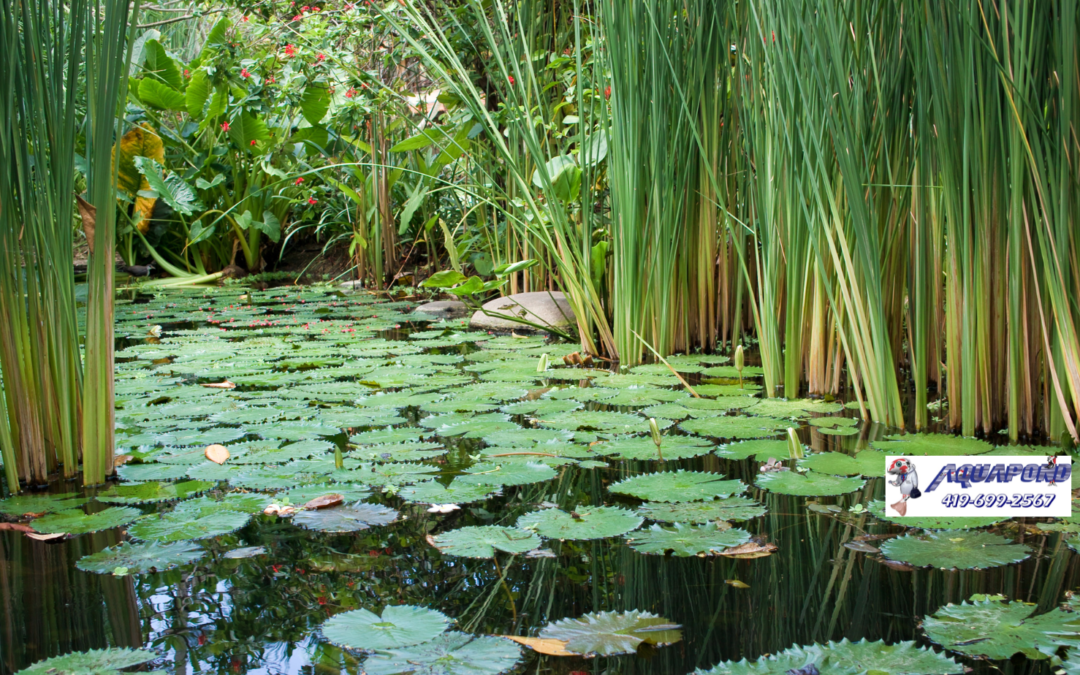A Troubleshooting Guide for Ohio Pond Owners
Owning a pond can be a rewarding experience, offering a peaceful retreat and enhancing the beauty of your property. However, maintaining a pond also comes with its share of challenges. From algae overgrowth to fish health issues, a variety of problems can affect the health and appearance of your pond.
At AquaPond, we’ve spent over 20 years helping Ohio pond owners like you address these common issues and ensure their water features remain healthy and attractive. In this guide, we’ll explore some of the most frequent pond problems and provide practical solutions to help you keep your pond in top condition.
Algae Overgrowth
Algae overgrowth is a common issue for pond owners, especially during Ohio’s warm summer months. Simple solutions can manage algae overgrowth. High nutrient levels, abundant sunlight, and poor water circulation create the perfect conditions for algae to thrive. Reducing nutrient runoff and introducing aquatic plants that compete with algae for resources can prevent algae blooms. Installing a pond aerator to improve water circulation is another easy step you can take.
If algae have already taken hold, natural solutions like beneficial bacteria or barley straw can be effective alternatives to chemical treatments.
Murky or Cloudy Water
Murky water, caused by suspended particles such as sediment and organic matter, is a common complaint among pond owners.
In Ohio, heavy rains can exacerbate this issue by washing soil and debris into ponds. Mechanical filtration systems and sedimentation agents can be employed to remove particles and clear up cloudy water. Long-term solutions include planting aquatic vegetation around the pond edges to reduce runoff and establishing a buffer zone with native plants to filter out sediments before they reach the water.

Low Oxygen Levels
Low oxygen levels, or hypoxia, can be detrimental to the health of your pond’s ecosystem, particularly for fish. Symptoms of oxygen deficiency include fish gasping at the surface and slow-moving or lethargic behavior.
Installing an aerator or fountain effectively diffuses oxygen throughout the pond, ensuring that aquatic life remains healthy. Preventive measures include maintaining good water circulation, avoiding overstocking fish, and regularly removing debris to reduce the pond’s organic load.
Invasive Aquatic Plants
Invasive aquatic plants, such as cattails and duckweed, can quickly dominate a pond, disrupting the ecosystem and reducing biodiversity. Managing these plants often requires mechanical removal and targeted herbicide application. In some cases, introducing plant-eating fish like grass carp can provide long-term control.
After removal, regular monitoring and maintenance are essential to prevent invasive species from re-establishing themselves in the pond.
Fish Health Issues
Fish health problems can be challenging to diagnose but are often indicated by symptoms like erratic swimming, lesions, or fin rot.
Poor water quality or sudden environmental changes are common causes of these issues. To address fish health problems, start by testing water quality to identify any imbalances in pH, ammonia, or nitrate levels. Treatment often involves improving water conditions, using medications or water treatments, and quarantining affected fish to prevent the spread of disease.

Unpleasant Odors
Foul odors emanating from a pond are usually the result of decomposing organic matter, such as leaves and dead algae, coupled with low oxygen levels.
Increasing aeration is the most effective way to eliminate these odors, as it accelerates the breakdown of organic material without producing unpleasant gases. Regular debris removal and beneficial bacteria can also help keep your pond smelling fresh, even during warm weather.
Excessive Muck and Sediment Build-up
Muck and sediment build-up is a natural process in ponds, resulting from decomposing organic material like leaves and fish waste. Over time, this accumulation can reduce water depth and degrade water quality. To manage excessive muck, consider using a pond vacuum or manual dredging to remove sediment physically.
Beneficial microbes can also accelerate the breakdown of organic matter, reducing the overall muck load in your pond and helping maintain a healthy environment.
Unbalanced Water Chemistry
Water chemistry imbalances, such as pH swings or high ammonia levels, can stress aquatic life and lead to health issues like algae blooms and fish. Regular water testing is essential to identify and correct these imbalances before they cause significant harm.
Adding buffering agents, performing partial water changes, and using water conditioners are common methods to stabilize water chemistry. Keeping a close eye on water quality, especially after heavy rains or seasonal changes, will help ensure your pond remains a balanced and thriving ecosystem.
Need Professional Help?
While common pond problems can be easily managed with the right knowledge and tools, we understand that sometimes you may need expert assistance. Our pond maintenance kits provide everything you need to tackle issues like algae control, fish health, and water clarity. And if you need further advice or professional help, our experienced team is always ready to assist you.
Contact us for a free consultation, and let us ensure your pond remains in pristine condition.



